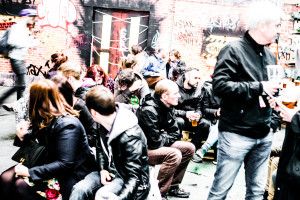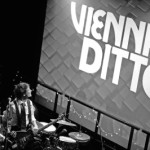 2015 was always going to be a landmark year for Liverpool Sound City. One of this country’s best Metropolitan festivals was leaving its original city centre setting and moving to a new location in the Liverpool Docklands. Anyone who attended Sound City in the last few years would agree that the sheer size and scale of the event was overstretching the capacity of small central venues, making it nearly impossible to see some of the bigger headliner acts. The new location has given the festival room to expand its capacity, allowing big names to occupy bigger stages as well as providing impressive visual spectacles.
2015 was always going to be a landmark year for Liverpool Sound City. One of this country’s best Metropolitan festivals was leaving its original city centre setting and moving to a new location in the Liverpool Docklands. Anyone who attended Sound City in the last few years would agree that the sheer size and scale of the event was overstretching the capacity of small central venues, making it nearly impossible to see some of the bigger headliner acts. The new location has given the festival room to expand its capacity, allowing big names to occupy bigger stages as well as providing impressive visual spectacles.
First up was the Sound City conference that took up its new residence in the brand new Titanic Hotel situated a short walk from the festival hub at Bramley Moore Dock. It was, without a doubt, a more atmospheric and functionally appropriate location. Despite its rather less salubrious environs, consisting mainly of the derelict remnants of Liverpool’s commercial docks, the impeccable organisation and friendly vibe soon made it a welcoming place. As usual, the conference offered a multitude of learning and networking opportunities for students and professionals. How? panel sessions covering broad range subjects, such as breaking international acts into the UK market, festival bookings, print vs online publications and tips for budding designers and videographers. The Market Place, teeming with stalls representing professional services, also hosted a series of Roundtable discussions and networking meet ups. However, by far the most popular events proved to be In Conversation stage interviews featuring local heroes like James Barton (aka co-founder of Cream and – according to Rolling Stone – ‘the most powerful man in dance music’), international superstars viz. Wayne Coyne, and savage music legends Mark E Smith and Julian Cope. Doing a stage interview with Mark E Smith was always going to be a prickly undertaking, even when the person asking the questions was a fellow Mancunian VIP and seasoned interviewer Dave Haslam. The Fall’s mastermind’s answers followed their own logic at times but were nonetheless more poignant and insightful than a great deal of what read in 21st centre PR-friendly press. When Dave Haslam cited the lyrics of ‘Lost in Music’ (‘Lost in music/Caught in a trap/There’s no coming back’) Mark E Smith responded, ‘Is this the theme of the conference?’ The In Conversation finale of the first day was given to Edwyn Collins, who talked with humour and humanity about his life in music and his comeback after a life-threatening illness, later performing a number of songs accompanied by a string quartet. Not a dry eye in the room watching him sing ‘I feel alive. I feel reborn.’
International showcases have also become a traditional and hotly anticipated feature of Sound City, and this year’s offerings included some of the most exciting acts of the entire festival. Noisy and provocatively sexy Latvian ukulele-wielding hip hop punks Triana Park got a very enthusiastic reception from the local crowd. Despite its early slot, Saturday’s Aussie BBQ (yep – complete with a delicious food!) got everyone in the mood to party: the entire tent was two-stepping to the rising star of Aussie hop hop Remi and transfixed by the might and swagger of Sydney’s rock giants Service Bells. Later the same day, Quebec’s Pop Montreal showcase unleashed an artist whose humour, raw passion and seemingly insatiable ability to absorb musical styles made him almost impossible to pin down. Forest in His Heart‘s visceral performance was poetic, personal and fearless, drifting from funk to electro pop, reggae and rock.

Sunday audiences were treated to the heavy rock blues of Korean Dead Buttons and a blistering performance from one of Cardiff’s hottest new indie acts Houdini Dax.
But national showcases were not the only places to discover new talent. Most of the stages gave space to new artists allowing audiences a chance to see some of the best emerging talent from across the world. Those unfamiliar with Barberos‘ alien lycra-clad, balaclava-wearing stage outfits and electro noise sound, may have been a little shocked. Visually arresting and sonically unbound, this Liverpudlian trio (two drummers and one synth master) were another testament t0 the boldness and inclusivity of the Sound City vision. French actress and singer Cecile Cassel (aka HollySiz) gave an ultra confident Blondie-inspired dramatic performance, that won over the curious crowd of early festival arrivals on Friday afternoon.
West Yorkshire gang Allusondrugs already have a fierce reputation in their home town of Wakefield; and their furious, urgent stage antics were certainly appreciated by the Sound City audiences.

George Mpanga, better known as George the Poet, is a Cambridge graduate born to Ugandan parents and brought up on an inner-city London estate. Definitely not an artist afraid of making political statements and offering social comment, his engaging personality and energy translated into a super tight and biting spoken word/rap performance.
Sound City’s musical diversity also makes it rather unusual amongst UK festivals. Folk, rap, hip hop, rock, indie, psych, funk and blues… it’s hard to find a genre not represented at the festival. One of the most interesting acts was a Welsh kosmische-driven techno supremo R. Seiliog. His 2013 debut album Doppler was justifiably praised by the music press and the Manic’s James Dean Bradfield. This year’s album, In HZ, took its metronomic propulsion further, resulting in utterly compelling sonic enchantment. The vast space of the Baltic stage resonated with the alien vibes of R.Seilog’s sonic constructions, merging pummelling guitars and cosmic electronic beats. Droplets of sound intensified by an urgent rushing pulse, skilfully navigating the planes between rock, electronic and dance music.
The festival’s Docklands move also promised the audiences a totally immersive experience. Sound City CEO, David J Pichilingi, pledged to create ‘the widest ever arts and culture programme… [offering] installations and spectacles to entice and delight.’ From Brazilica Carnival processions (think Rio carnival meets Mad Max) to the giant surreal illuminated puppets of Liverpool’s own Lantern Company, the roving lindy hip hop troupe and the brass’n’rave-enthused choreography of REVOLT, inspired by 1984 miner strike and performed by Edgefwd Dance Theatre, Sound City more than delivered on its promise. In truth, despite many regulars’ attachment to the former city-centre location none of this would have been possible – or at least had the same visual impact – in the setting of the old Ropewalks festival home.
And, of course, it’s impossible not to mention the incredible headliners.

Giving Friday night’s hot spot to Swans was a brave move. The younger (or less masochistic) crowd drifted towards the main Atlantic stage to enjoy The Vaccines, but those who dared to enter the giant warehouse space of the Baltic Stage were rewarded by a colossal performance. And it was loud! At times it felt like foundations of the vast Victorian warehouse were shaking with majestic shamanic fury. Earplugs may have been a medical requirement for this gig; they may have only got through a couple of tracks in the first hour, but the setting of the giant warehouse with a night-time Liverpool skyline in the background made it an awesome experience.

On Saturday night the festivals focus shifted towards the Atlantic stage in anticipation of The Flaming Lips. Watched over by a drone flying above and dressed in a plastic green, yellow-dotted frogsuit complete with a raccoon tail and Dora the Explorer pink ukulele, Wayne Coyne delivered a crowd-pleasing set that predictably included ‘Yoshimi Battles the Pink Robots’ (according to Wayne, ‘Song made a lot better when sang loudly, by a bunch of fucking drunk people’) and ‘Do you realize??’. After the forth track Wayne summoned his two ‘very special guests’ and the happy crowd witness a successful marriage proposal. Anyone who’d seen The Flaming Lips in action before knows what to expect. Yet, the band’s totally off-kilter psychedelic theatrics lost none of their magical hallucinogenic quality. Love was all around the dreamscape of The Flaming Lips opera radiating the most profound sense of joy and well-being. No illegal substances required.
Belle and Sebastian can boast serious musical credentials and a faithful fanbase. However, their no-fuss attitude was overshadowed by the majesty of the previous night’s main stage headliners. Peace, on the other hand, proved that they had grown into serious major headliner contenders. Simultaneously raucous and debilitatingly charming, the band’s frontman Harry Koisser worked the crowd with ease. However, the supreme act of the night didn’t arrive on the stage till way past midnight. The Baltic stage easily rivalled the main Atlantic stage for the quality of its line up. The more emerging, left-field slant proved popular, and booking Fat White Family as their after-hours headliner had a touch of genius. No other band do rock’n’roll and let it rip the way they did. Sweat, blood and nudity were all part of the deal. Not in a premeditated stage-managed. No, these were true pretenders, the real thing. There was crowdsurfing, moshpits, euphoric dancing and an ever-present menace rising above the sound of their filthy sleaze rock.
Sadly, a single review doesn’t capture the sheer variety and quality of the line up that included the incredible Unknown Mortal Orchestra, Mancunian electro maestro Lonelady, fresh synth pop enthusiasts Becky Becky and Heavenly’s latest signing Hooton Tennis Club among a myriad of sights and sounds of Sound City 2015. Predictably, there were a few teething problems with the new location. Sound bleed was a persistent issue in the central area, with four stages clustered close together. Chips and burgers seemed to be the dominant cuisine. £4.50 for a pint of unremarkable lager didn’t prove to be a big hit with the locals either. Although the festival ran half-hourly shuttle buses from the main train station to the site, there was nothing on offer at the end of the night. With taxi queues stretching into the night, most of the punters were forced to walk 1.8 miles back into the centre. It may not seem like a serious distance but after a whole day of standing and walking around the docks it clearly presented a challenge to many.
However, at the end of the four days it felt like a new beginning: a way of opening up the festival to wider audiences, an opportunity to regenerate an area closely linked to the heritage of the city and a new way of presenting a city festival. Thanks you Sound City, and see you in 2016!
Photo credit: Mike Hughes




